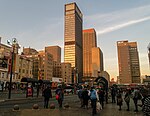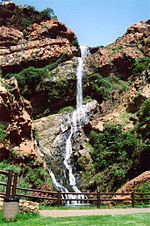Kine Centre
1974 establishments in South Africa20th-century architecture in South AfricaOffice buildings completed in 1974Skyscraper office buildings in JohannesburgSouth African building and structure stubs ... and 1 more
Use South African English from March 2024
The Kine Centre is a modern style skyscraper in the Central Business District of Johannesburg, South Africa. It was built in 1974 to a height of 123 metres. The building has 25 floors of office space, several large stores, a 10-screen cinema complex that seats 2500 people which is now mothballed, and two levels of underground parking. The building also has a famous penthouse located on the top floor. The Kine Centre is connected to the Carlton Centre via a pedestrian tunnel. The building was sold for Rand 9.1 million (USD $910,000) in February 2003.
Excerpt from the Wikipedia article Kine Centre (License: CC BY-SA 3.0, Authors).Kine Centre
Commissioner Street, Johannesburg Johannesburg Ward 60
Geographical coordinates (GPS) Address Nearby Places Show on map
Geographical coordinates (GPS)
| Latitude | Longitude |
|---|---|
| N -26.20458 ° | E 28.0463 ° |
Address
Klamson Towers
Commissioner Street 151
2001 Johannesburg, Johannesburg Ward 60
Gauteng, South Africa
Open on Google Maps










